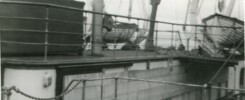
The 9th November dawned with Jeanie Deans still sheltering in the lee of the NE corner of the Isle of Man in Ramsey Bay on her voyage from the Clyde to the Medway. By this time her bunkers were starting to look a tad on the low side. Something had to be done about topping them up.
Remember here that Clyde paddle steamers were built to be light draft to get in and out of Craigendoran. Fuel is a heavy weight to carry about so the less you carry at any one time the higher the ship will float in the water. So all these paddle steamers had fairly limited bunker capacities to suit a day only ferry and excursion trade and were not designed for extended coastal passages with the ship at sea burning fuel twenty-four hours a day every day.
According to Tony McGinnity’s sale leaflet for the ship in 1967 Jeanie Deans could burn 1.75 tons per hour with the engine running at 60 revolutions per minute flat out or 1 ton per hour at a more economical cruising speed of 52 rpm. For excursions on the Clyde in say an 8-hour day that would come in at 8 tons to 12 tons if she was pushed which comes in at around maybe 50/60 tons in a week depending on the programme.
However, steaming round the clock on a positioning run twenty-four hours a day that is 24 tons to 40 tons flat out a day which empties the bunkers at a speedy old rate.
Chief Engineer Arthur Blue recalls “We had to resume our passage for Holyhead where fresh bunkers had been ordered. Water was less of a worry as I was now prepared to take saltwater feed in an emergency though hopefully not. The mate, who was actually an aviator in his other life, reckoned that we ought to sight Holyhead mountains before dark but as dusk descended in rather poor visibility there was no sign of land and meanwhile the bob of the sounding tape was making clanging noises on the bottom of the bunker tanks.”
“We reduced speed to the minimum to save fuel and carried on in darkness eventually creeping into the berth on the last flickers of flame from the burners and water below the bottom of the nut in the gauge glasses. With a big sigh of relief we found a bunkering truck and a water hose waiting for us.”
“To celebrate the cook served up more Fray Bentos steak pies and a peaceful night was spent alongside.”
Continue to part 11 of 13 here or go back to part 1 here.
Kingswear Castle returned to service in 2023 after the first part of a major rebuild which is designed to set her up for the next 25 years running on the River Dart. The Paddle Steamer Kingswear Castle Trust is now fund raising for the second phase of the rebuild. You can read more about the rebuilds and how you can help if you can here.
John Megoran
This article was first published on 9th November 2020.


